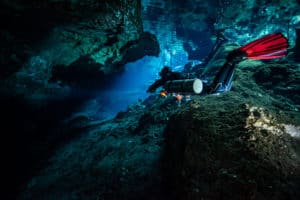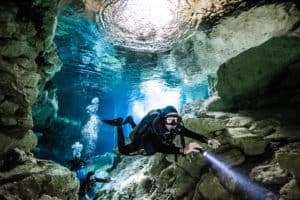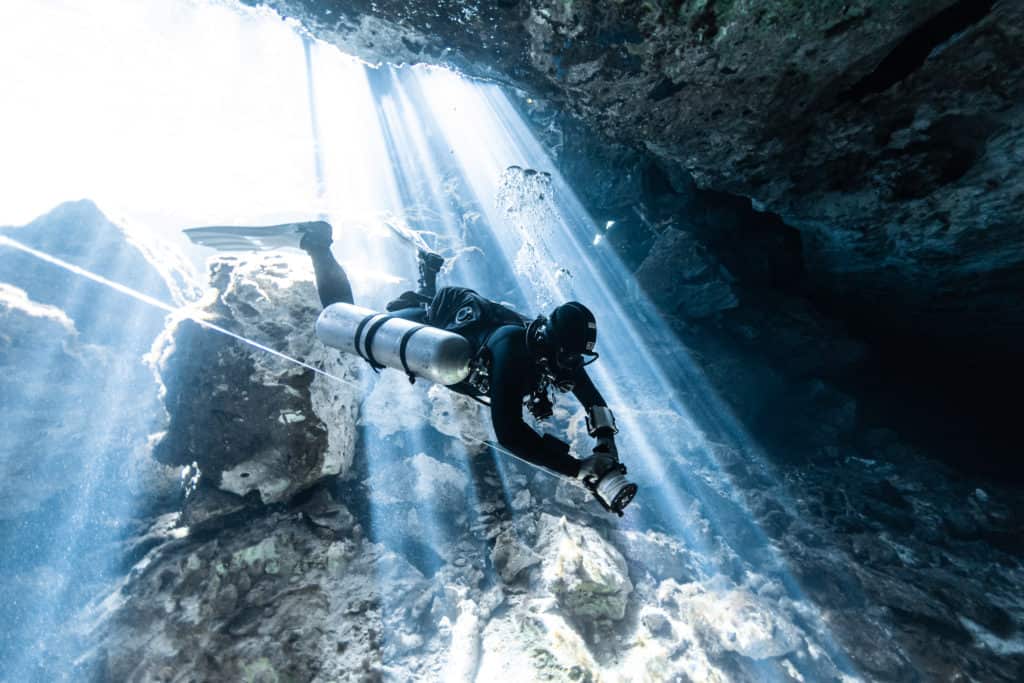As an open water diver, we know the ocean is fantastic, but have you tried cenote scuba diving? How different is it from being in the open seas? Read on to find out!
How Does Cenote Scuba Diving Compare with Ocean Diving?
As scuba divers, diving beneath the ocean waves is always a great feeling. But have you ever wondered about cenote scuba diving, it actually differs quite a lot compared with the ocean!
In this blog, we will explain the differences between cenote scuba diving and diving in open water, so that you’ll be ready for your first cenote dive!
-
Salt Water vs Fresh Water
As we all know – the ocean is salty! That salty sea air smells great, but can actually be quite harsh on divers. It can dry out your hair and skin. Plus, it can affect the lifespan of your dive equipment if you don’t maintain it carefully.
On the other hand, cenotes have fresh water (or as the locals often call it – sweet water!)
There’s no saltiness, and no taste, which can be a bit weird if you’re only used to diving in the ocean.

-
Cenote Scuba Diving is Cavern Diving
Cenote diving is classed as a ‘cavern’ dive. A cavern is classed as the entrance to a cave and needs to be within 130 ft / 40 meters of the outside natural light at all times.
There are specialty courses you need to take if you were to do this type of dive alone, but in this region of the Mayan Riviera, there are plenty of certified and qualified guides who are able to show you the cenotes, even if you are only an open water diver.
Caverns, as you will expect, are also darker, so you will use a flashlight on your dive to look for interesting things and find your way.
-
Diving in an Overhead Environment
When you dive in the ocean, you can almost always ascend to the surface above in case of an emergency situation. But when you are cenote scuba diving, you’re in an overhead environment, so can’t just ‘go up’.
Emergency situations require a little more consideration, as you have to swim towards the light of the cavern entrance, which may be behind you.
The height of the cavern also means that you need to be aware of your buoyancy, as you don’t want to bash into the stalactites and stalagmites
-
Gas Management is Imperative
As cenote diving is a little more dangerous, due to the overhead environment, and the fact that you can’t surface in an out-of-air situation, you have to be more aware of your gas management.
During a cenote scuba dive, you follow the ‘rule of thirds’ where you use a third of your tank to enter the cavern, and then a third of the tank to return to the entrance. That leaves a third of the tank full of air for any emergency.
Most cenotes are actually really shallow, so you may find that you don’t even use a lot of air on your dive anyway, but it is something you need to be very aware of.
Cenote guides are obliged to wear 2 tanks when leading a cenote dive, so you will often see them in a sidemount configuration.

-
Awesome Visibility
There’s nothing worse than taking a giant stride into the ocean and not being able to see a thing due to a lack of visibility or a silted-up bottom. If you’ve been known to frequent lakes when diving a lot, you may even be aware of not being able to see your own hand in front of your face!
For us lucky enough to dive the cenotes, the opposite is thankfully true…
Cenotes have wonderful water clarity, and the visibility is almost endless! In fact, you’re more likely to not be able to see in the distance due to the lack of light, rather than the murkiness of the water.
-
No Wandering! Follow the Line
When diving in the ocean, you’re free to follow the reef and navigate where your heart chooses to take you. In a cenote, this is very different. You need to follow a laid-out line.
This is a pre-plotted route that has been designated for your guide team to follow. The string is actually tied onto the rocks within the cenote to show the route – and it is imperative that you do not wander away from the line.
Many cenotes have entrances and other caves within them, and wandering away from the line could be fatal.
-
You need a Specially Trained Guide
To be a cenote guide, you need to be a specially certified cave diver. The regulations are very tight on who can take you to these sacred spots to experience the wonder of cenotes.
Always use a reputable company, such as DivePoint, when booking your cenote diving days.
-
‘Conga Line’ Not Buddies
Usually, when you dive in the ocean, you are paired into buddy teams and stay next to, or close to a buddy when diving.
In a cenote, you dive in a long ‘conga line’ (one behind the other) with the guide at the front, and usually the more experienced divers towards the back.
It’s also important not to kick up the sediment on the cavern floor, or you could cause problems for those behind you.
-
Differing Hand Signals
As divers, you are all aware of the hand signals for diving, but in a cenote, they differ. This is because when you are in that longer ‘conga line’ of divers, you aren’t facing your dive buddies to communicate as frequently.
Also, it’s dark in a cenote, so even if you do signal to a buddy, they may not be able to see your hands clearly.
You will use your flashlight to communicate. In an emergency, you will shake the light beam in a back-and-forth direction ahead of the guide so they can see it.
If all is ok, you draw a slow circle using the torch beam or you can point the light at your hand making an ok signal.
-
No Boat
Cenotes are found in the middle of the jungle, so you need a large truck rather than a boat to access them.
This is great if you suffer from sea sickness, as you won’t have the rocking boat to contend with.

-
Cenote Water is Colder than the Caribbean Sea
Cenotes are colder than the local ocean of the Caribbean. Cenotes tend to remain at around 26°C/79°F year round. Whereas the ocean is around 29°C/84°F in the winter, and around 30°C/86°F in the summer months.
This means that using a neoprene wetsuit in cenotes is a must if you want to keep warm, compared to the ocean where diving in a rash guard for some people is absolutely fine.
Often the cenote guides and local cave divers even wear dry suits for cenote diving to stay warm and dry.
-
Less Marine Life
You should not expect to see much in the way of marine life in cenotes. There are some smaller catfish, and some other little fish that live there, but they are not explored in order to see the life inside them.
Cenote diving is more to see the majesty of the cavern and the decorative speleothems and rock formations inside them.
-
Experience Incredible Haloclines
A lot of the cenotes have halocline layers, where the freshwater of the cenote mixes with a saltwater river that runs through.
You can sometimes see this as a blurry patch within a cenote, or feel it as a temperature change.
Cenote Scuba Diving is Amazing
Now you know about many of the differences between cenote scuba diving and ocean diving, the next step is to experience it for yourself.
At DivePoint we can take you to a whole host of cenotes, with some great for beginners, and others more specialized which require more skill.
They are all beautiful though!
We can also combine cenote diving with some ocean dives so that you can experience the best of the Riviera Maya in one fun-filled diving package.
Contact us for more information.
Thanks for reading and we hope you enjoyed this blog about the Differences between Ocean and Cenote Scuba Diving Mexico!
If you enjoyed reading, make sure to read our other blog topics, leave us a comment, or follow us on our Facebook & Instagram pages!


